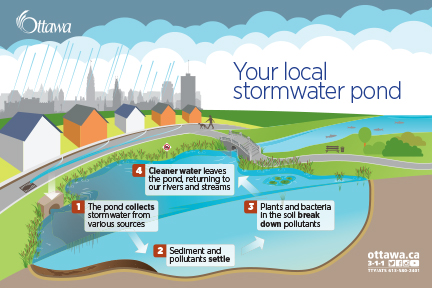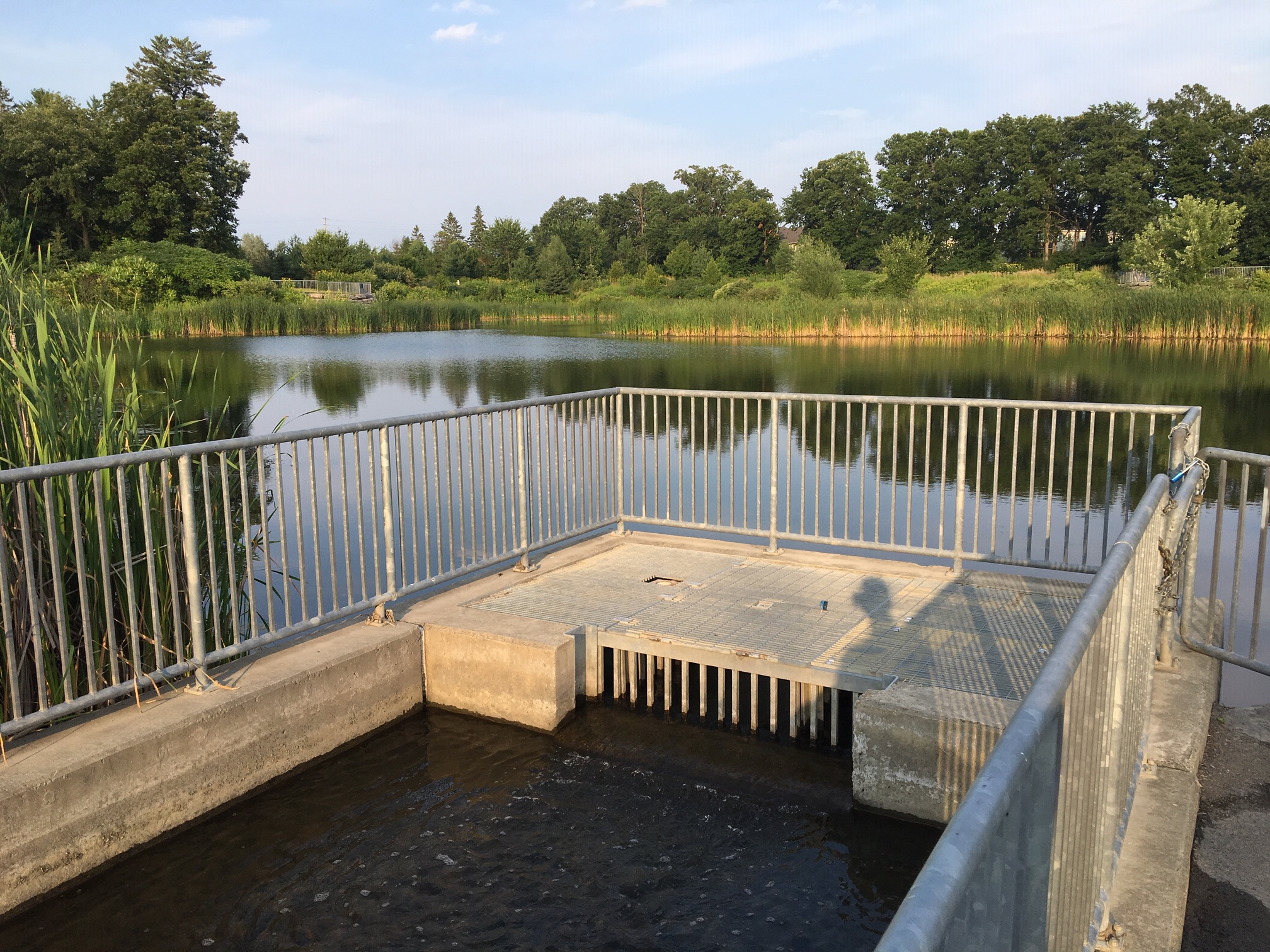This earthcache may not be possible to complete throughout the winter.

Viewed from above, the pond in Half Moon Bay District Park looks a bit strange. But this is no ordinary pond; this is a specially constructed stormwater pond. Its purpose is to give surface runoff from the nearby neighbourhood a place to go, and to clean that water before it enters the Jock River, to the northwest.
“Stormwater” refers to rainfall and other surface runoff, and the journey it takes between falling from the sky and entering a river or lake. The City of Ottawa uses and promotes a variety of measures to manage stormwater levels and quality in order to minimize its impact on property, infrastructure, and the natural environment. These measures may be implemented at ground level (e.g. using rain barrels to store water temporarily), in the sewer system (e.g. catch basins that prevent large debris from entering underground pipes), or after the water exits the sewer system (e.g. biofilters).

Stormwater ponds are an example of an “end-of-pipe measure”. They receive stormwater runoff through the sewer system and store it for a time, to allow sediments, debris, and pollutants to settle before the water enters a natural waterway. The controlled release of the stormwater also helps prevent flooding and erosion. The City of Ottawa uses three main types of stormwater ponds:
- Dry ponds, such as depressions in parks, temporarily hold water after significant rainstorms, to keep the sewers from becoming overloaded.
- Infiltration ponds rely on sandy soil to clean the water as it percolates down to replenish groundwater.
- Wet ponds, like this one, are permanent wetlands. They always contain a minimum volume of water, which fluctuates as stormwater pours in from the sewers and then empties into the downstream waterway. The water must reach a certain depth in order to pass through the outlet, ensuring there will always be enough water to sustain the wetland habitat.

As stormwater moves overland and through the sewer system, it picks up sediments, debris, and pollutants and transports them toward the stormwater pond. The ability of water to transport various particles depends on the velocity of the water and the size of the particles. Water flows fastest when confined to a narrow channel or when flowing downhill, and slowest when it has room to spread out laterally or when there is little elevation change. The faster the flow, the larger the particles the water can carry. Stormwater ponds serve as locations where the fast-flowing stormwater can spread out and slow down, causing the particles to settle to the bottom. The longer the water remains stored in the pond, the more sediments, debris, and pollutants will settle, cleaning the water before it exits through the outlet.
Sources
- City of Ottawa. Stormwater collection and facilities. Retrieved July 25, 2019 from <https://ottawa.ca/en/residents/water-and-environment/stormwater/stormwater-collection-and-facilities>
- Earle, S. (2015). Physical Geology. Victoria, BC.: BCcampus. Retrieved July 26, 2019 from <https://opentextbc.ca/geology/chapter/13-3-stream-erosion-and-deposition>
-------------------------------------------------
To log this earthcache as found, first e-mail me the answers to the first four questions (don’t post them in your log!). You may log it as found without hearing a response from me, but e-mails with missing or poor answers may be deleted, and the cacher notified as to the reason(s) why.
Questions
1. Observe the water at the inlet and outlet. Does more water appear to be entering or exiting the pond today? Does this mean the water level is rising, falling, or neither?
2. Estimate or measure the height of the metal fence at waypoint 2, in metres. If the depth of the pond is 1.5x the height of the fence, how deep is the pond?
3. If the area of the pond is approximately 9,200 m2, what is the approximate volume of water in the pond? (Multiply 9,200 m2 by your answer to question 2.)
4. From waypoint 3, you have a good view of one of the two peninsulas that jut into the pond. In your own words, explain why it is beneficial that the peninsulas are here.
5. (Optional) Post a photo of yourself at any, or all, of the three waypoints.

FTF: Vhoneyman